What Does "Hidden Subject" Really Mean?
To understand the idea behind this urban intervention, let’s start with a Portuguese grammar lesson. In Portuguese, sujeito oculto means “hidden subject.” This grammatical rule allows you to construct a sentence without explicitly naming the person performing the action, because the verb itself makes it clear who the protagonist is. The subject is implied—present in meaning but invisible in the sentence’s structure.
For example: “(Eu) estou aqui,” translates to “(I) am here.” You can omit the subject (“Eu”/“I”) because the verb form indicates who is speaking. The subject remains in the background, even though it is essential to understanding the sentence.
This idea can be applied to social situations involving domestic abuse. When someone is verbally abused in public, they often become an unacknowledged “hidden subject.” People see what is happening and grasp the situation, yet the victim and their suffering become invisible. Bystanders may talk around the victim or even about them, but they rarely intervene. Although it may seem like none of your business, failing to act allows the abuser to erase the incident, and witnesses quickly forget. Meanwhile, the victim is left with an indelible memory.
The Genesis - The Day I Had To Protect My Identity
On Memorial Day in 2020, a friend asked me to help open his house on Fire Island for the season, delayed by the COVID lockdown. Normally I love this task, except that my ex-husband—whom I am still divorcing—also lives in that small community.
As I arrived, I recognized familiar faces. I made a quick decision: instead of wearing a mask over only my mouth and nose, I wrapped a scarf around my entire head, hiding every inch of my face. People stared, inspecting me as if searching for clues. Some seemed scared; others were curious or hostile, unnerved by a faceless figure in their midst.
That evening it hit me: Fire Island is the fantasy island known for wild and discombobulate outfits. Why not apply that creativity to full-face coverings? Elaborate masks would let me move freely without fearing recognition from my ex or his associates. This realization led me to think deeply about identity, protection, and the symbolism of masks. More importantly, it inspired the idea for a unique urban intervention: in a place that celebrates eccentric attires, wearing full-face masks could open a conversation about the elements of domestic violence that disrupt in public spaces, but rarelly get adressed.
Performance Protocol: Operational Framework
To transform this protective measure into an artistic urban intervention, I established a set of rules:
- Mandadory complete facial coverage whenever I leave my residence during daylight.
- Each mask must be unique for every appearance. Materials or elements may repeat, but the overall design must be distinct.
- No explanations or justifications about my mask choices are given during the performance.
- Mandatory public presence: I must pass through areas with foot traffic or gatherings—whether it’s a quick stop at the pantry or a walk through the commercial area.
- Protect my identity without disrupting interactions with friends; at all times, my face remains concealed.
- Communicate digitally only All information about this intervention is shared exclusively through my Instagram page, serving as the sole channel for verbal communication about the project.

Testing ideas on my way back to the Fire Island
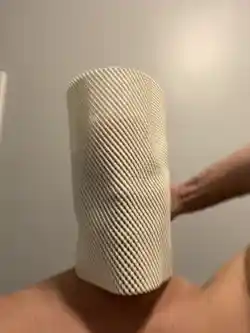
Testing the visual impact of a rubber mat as a mask
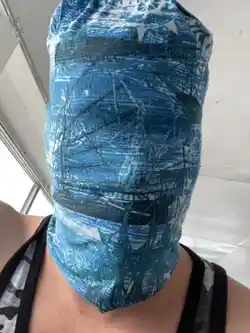
Loop scarfs are flexible and get comfortably on the face
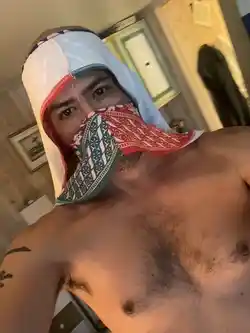
Some ideas were discarted by not fufilling the concept set for the project
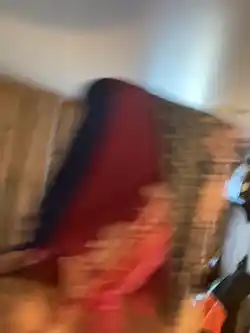
While others did not had the chance to be used due the abrupy interruption of this project
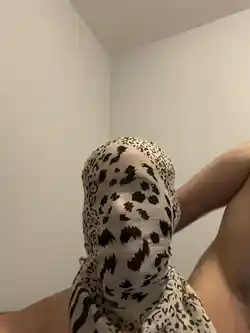
Testing new ways to use the leopard scarf from the first trip on the ferry
The performance aims to revisit the 3 maks used by different actors on when it comes to domestic violence in public enviroments. The First Mask--the one recognized by most people--is the victim, which may be a literal or metaphorical mask—as a survival mechanism. This mask has a dual purpose: they protect victims from abusers and conceal the abuse from friends, family, or community members.
The Second Mask is the one used by the individuals who witness the abuse blocking the sense of empathy, care towards the victim or even fear of the abuser, hving the power to block them from intervene in defense of the victim, or eveb awknowledge the abuse, becoming an accessory of this violence through their silence.
This lack of action supports the development of the Third Mask, the one used by the abuser presenting them as a “good partner” . This façade is carefully crafted, as losing that false identity is often a controlling spouse’s greatest fear.
An artistic urban intervention aims to disrupt the environment by introducing an element that challenges the status quo. Given the reaction I received when hiding my face on the ferry, I saw an opportunity to provoke a deeper conversation about who wears the mask and why they need to conceal their identity. The goal is to help each the differenct actors on this masked ball-the victim, abuser, or witness—to recognize their own mask so they can take action to stop the cycle of violence, or at least begin to talk about it.
Cross Subjects Promoted Over This Urban Intervention
Domestic violence victims experience different forms of abuse, but the ones that take place in front of other people may be the most damaging episodes, due nothing being done to stop the abusive partner. The silence of those witnessing the violence is a passive gaslighting of the victim, promoting that the abusive behavior isn’t problematic. They feel isolated and think they have no alternative to stop the aggression.
As a result, victims tend to adopt a mask, presenting a different reality than what they experience daily. This may involve using makeup to hide bruises or wearing clothing to cover evidence of abuse. For those suffering emotional and psychological abuse, the mask is more elaborate: they present a different persona that may even justify or romanticizes the abuse endured.
In this performance, the main character is the victim, hidden under masks to protect themselves from the abuser and to conceal their social identity. The masks incorporate symbols that victims often rely on to cope with constant abuse, such as faith/religion, luxury fashion, structure, protection, and numbness.
The main goal of this performance is to encourage individuals to recognize their own masks: as we all have used at least one of the three masks at least once.
The Multi-Layered Symbolism of Masks
Project Stages - 4 modules
- 1st – Introduction Introduce the masked character to the community, integrating them into island routines — Questioning Identity: Who are the actors involved in domestic violence?
- 2nd – Transition During the transition stage, the masks become larger and more aggressive, with dark exaggeration. This pushes boundaries and disrupts the scene rather than blending in. Showcasing the disruptive impact of Domestic Violence on social enviroments.
- 3rd – Revelation In this final stage, the masks reveal the face behind the allegory, exposing bruises and scars while still being present. Suggesting the flaws of masks in hiding evidence of abuse—something anyone can see, yet most ignore.
- 4th – Closure During closure, the artist removes the mask and makeup in public and invites the community to discuss the performance and the impact of domestic violence on the social environment. Raising awareness and emphasizes the importance of talking about domestic violence.
Historical Context
- Ana Mendieta's works addressing violence against women (later killed by her artist husband)
- Adrian Piper's "Mythic Being" persona as identity protection
- Tania Bruguera's censored political performances
The Tragic Recognition
"Playing with exaggerated styles as a cry for help or an attempt to get attention, but no one looks deeply enough to see what’s behind the colors or ask why there’s a mask there. People saw someone wearing unusual masks without trying to understand why they were hiding their identity. This mirrors what happens with victims of domestic violence, who carry invisible pain. The hidden subject remained hidden."
The Violent Interruption
Exactly when the audience began to understand the project and I was about to move towards Module 2 , my ex-husband acted to silence me, forcing the abrupt termination of "Sujeito Oculto."
The silencing was not coincidental - it happened precisely when the hidden subject was becoming visible.
The Forced Ending
The project's violent termination became its most powerful statement:
- Artistic freedom silenced by intimate partner violence
- Community engagement interrupted by private control
- Hidden subject forced back into invisibility
- The abuser's ultimate power - to stop the story being told
The Interrupted Narrative
The project's abrupt ending proves its thesis: hidden subjects remain vulnerable even when they find a voice, while others remain blind to what happens around them. Yet the documentation survived, and the artistic practice evolved.
The hidden subject is no longer hidden - but remains protected through artistic evolution.
"Sujeito Oculto" was silenced, but the artist survived to tell the story.